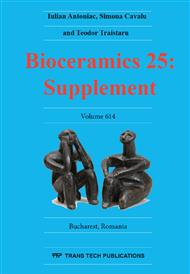[17]
Most cases of spondylodiscitis heal with antibiotic therapy, but large defects may be an indication for surgery.
Google Scholar
[1]
After radical debridement of the affected vertebra, some authors prefer to fill the defect with autologous or allogeneic cancellous bone [18, 19], while others use titanium cages filled with bone grafts [20, 21], as was done in this series. Well-fitting spacers leading to evenly distributed load transmission between the spacer and the supporting vertebrae can provide immediate stability. PMMA cylinders provide such an equal load transmission, but they bear a high risk of dislocation. Harms cages achieve close contact between grafts and supporting bone, but anterior distraction is necessary before implant insertion, imposing an unfavourable load on the vertebral screws.
Google Scholar
[22]
On the contrary, the Obelisc system is distractible in situ, and does not require the use of a supplementary distraction device. In situ distractibility was also seen as an advantage by Knop et al.
Google Scholar
[23]
Moreover, the Obelisc cage has spikes, the importance of which was stressed by Morlock et al.
Google Scholar
[24]
in a study on human cadaver specimens. Conclusions. One-stage surgical treatment for spondylodiscitis by antero-posterior surgical approach with posterior instrumentation and anterior reconstruction with vertebral body replacement device filled with composite antibiotic carrier is a feasible and effective method. In situ distractible vertebral body replacement systems allow for a stable customised restoration of the anterior column of the spine. Spikes prevent loosening of the cage. Bibliography.
DOI: 10.1055/b-0034-75898
Google Scholar
[1]
M.C. McHenry, K.A. Easley, G.A. Locker, Vertebral osteomyelitis: long-term outcome for 253 patients from 7 Cleveland-area hospitals, Clin Infect Dis 34 (2002) 1342–50.
DOI: 10.1086/340102
Google Scholar
[2]
O. Safran, N. Rand, L. Kaplan, S. Sagiv, Y. Floman, Sequential or simultaneous, same-day anterior decompression and posterior stabilization in the management of vertebral osteomyelitis of the lumbar spine, Spine (Phila Pa 1976) 23 (1998) 1885–90.
DOI: 10.1097/00007632-199809010-00018
Google Scholar
[3]
F.L. Sapico, J.Z. Montgomerie, Pyogenic vertebral osteomyelitis: report of nine cases and review of the literature, Rev Infect Dis 1 (1979) 754–76.
DOI: 10.1093/clinids/1.5.754
Google Scholar
[4]
S. Endres, A. Wilke, Posterior interbody grafting and instrumentation for spondylodiscitis, J Orthop Surg (Hong Kong) 20 (2012) 1-6.
DOI: 10.1177/230949901202000101
Google Scholar
[5]
E.J. Carragee, Instrumentation of the infected and unstable spine: a review of 17 cases from the thoracic and lumbar spine with pyogenic infections, J Spinal Disord 10 (1997) 317–24.
DOI: 10.1097/00002517-199708000-00007
Google Scholar
[6]
F. Grados, F.X. Lescure, E. Senneville, R.M. Flipo, J.L. Schmit, P. Fardellone, Suggestions for managing pyogenic (non-tuberculous) discitis in adults, Joint Bone Spine 74 (2007) 133–9.
DOI: 10.1016/j.jbspin.2006.11.002
Google Scholar
[7]
M. Soehle, T. Wallenfang, Spinal epidural abscesses: clinical manifestations, prognostic factors, and outcomes, Neurosurgery 51 (2002) 79–87.
DOI: 10.1097/00006123-200207000-00013
Google Scholar
[8]
A.G. Chacko, R.K. Moorthy, N.J. Chandy, The transpedicular approach in the management of thoracic spine tuberculosis: a short-term follow up study, Spine 29 (2004) 363-367.
DOI: 10.1097/01.brs.0000137063.64650.e1
Google Scholar
[9]
J.R. Dimar, L.Y. Carreon, S.D. Glassman, M.J. Campbell, M.J. Hartman, J.R. Johnson, Treatment of pyogenic vertebral osteomyelitis with anterior debridement and fusion followed by delayed posterior spinal fusion, Spine 29 (2004) 326–32.
DOI: 10.1097/01.brs.0000109410.46538.74
Google Scholar
[10]
R.M. Ozuna, R.B. Delamarter, Pyogenic vertebral osteomyelitis and postsurgical disc space infections, Orthop Clin North Am 27 (1996) 87–94.
DOI: 10.1016/s0030-5898(20)32053-8
Google Scholar
[11]
S.E. Emery, D.P. Chan, H.R. Woodward, Treatment of hematogenous pyogenic vertebral osteomyelitis with anterior debridement and primary bone grafting, Spine (Phila Pa 1976) 14 (1989) 284–91.
Google Scholar
[12]
D. Fang, K.M. Cheung, I.D. Dos Remedios, Y.K. Lee, J.C. Leong, Pyogenic vertebral osteomyelitis: treatment by anterior spinal debridement and fusion, J Spinal Disord 7 (1994) 173–80.
DOI: 10.1097/00002517-199407020-00012
Google Scholar
[13]
R.A. McGuire, F.J. Eismont, The fate of autogenous bone graft in surgically treated pyogenic vertebral osteomyelitis, J Spinal Disord 7 (1994) 206–15.
DOI: 10.1097/00002517-199407030-00002
Google Scholar
[14]
A.G. Hadjipavlou, J.T. Mader, J.T. Necessary, A.J. Muffoletto, Hematogenous pyogenic spinal infections and their surgical management, Spine (Phila Pa 1976) 25 (2000) 1668–79.
DOI: 10.1097/00007632-200007010-00010
Google Scholar
[15]
R.K. Osenbach, P.W. Hitchon, A.H. Menezes, Diagnosis and management of pyogenic vertebral osteomyelitis in adults. Surg Neurol, 33 (1990) 266–75.
DOI: 10.1016/0090-3019(90)90047-s
Google Scholar
[16]
C.E. Heyde, H. Boehm, H. El Saghir, S.K. Tschoke, R. Kayser, Surgical treatment of spondylodiscitis in the cervical spine: a minimum 2-year follow-up, Eur Spine J 15 (2006) 1380–7.
DOI: 10.1007/s00586-006-0191-z
Google Scholar
[17]
A.H. Fayazi, S.C. Ludwig, M. Dabbah, R. Bryan Butler, D.E. Gelb, Preliminary results of staged anterior debridement and reconstruction using titanium mesh cages in the treatment of thoracolumbar vertebral osteomyelitis, Spine J 4 (2004) 388–95.
DOI: 10.1016/j.spinee.2004.01.004
Google Scholar
[18]
J.S. Lee, K.T. Suh, Posterior lumbar interbody fusion with an autogenous iliac crest bone graft in the treatment of pyogenic spondylodiscitis, J Bone Joint Surg Br 88 (2006) 765–70.
DOI: 10.1302/0301-620x.88b6.17270
Google Scholar
[19]
C. Hopf, A. Meurer, P. Eysel, J.D. Rompe, Operative treatment of spondylodiscitis—what is the most effective approach? Neurosurg Rev 21 (1998) 217–25.
DOI: 10.1007/bf01105775
Google Scholar
[20]
U. Liljenqvist, T. Lerner, V. Bullmann, L. Hackenberg, H. Halm, W. Winkelmann, Titanium cages in the surgical treatment of severe vertebral osteomyelitis, Eur Spine J 12 (2003) 606–12.
DOI: 10.1007/s00586-003-0614-z
Google Scholar
[21]
O. Suess, L. Weise, M. Brock, T. Kombos, Debridement and spinal instrumentation as a single-stage procedure in bacterial spondylitis/spondylodiscitis, Zentralbl Neurochir 68 (2007) 123–32.
DOI: 10.1055/s-2007-984461
Google Scholar
[22]
Z. Klezl, C.A. Bagley, M.J. Bookland, J.P. Wolinsky, Z. Rezek, Z.L. Gokaslan, Harms titanium mesh cage fracture, Eur Spine J. 16 (2007) 306-10.
DOI: 10.1007/s00586-007-0377-z
Google Scholar
[23]
C. Knop, U. Lange, L. Bastian et al., Vergleichende biomechanische Kompressionsversuche mit einem neuen Wirbelkörperersatzimplantat, Unfallchirurg 104 (2001) 25-33.
DOI: 10.1007/s001130050684
Google Scholar
[24]
M. Morlock, J. Strandborg, K. Sellenschloh et al., Migration Characteristics and primary stability of vertebral body replacement systems in combination with dorso lumbar spondylodeses, Orthopäde 31 (2002) 514-521.
DOI: 10.1007/s00132-001-0294-5
Google Scholar


